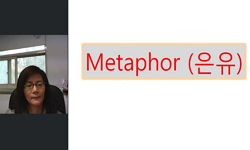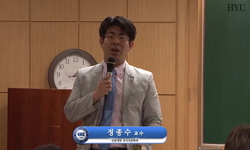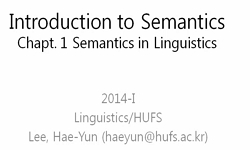The purpose of this article is to evaluate the use of ‘ma-eum’ in Korean translations in light of the concept of the illegitimate totality transfer. In 1961, James Barr, a British biblical scholar, coined the term ‘illegitimate totality transfer...
http://chineseinput.net/에서 pinyin(병음)방식으로 중국어를 변환할 수 있습니다.
변환된 중국어를 복사하여 사용하시면 됩니다.
- 中文 을 입력하시려면 zhongwen을 입력하시고 space를누르시면됩니다.
- 北京 을 입력하시려면 beijing을 입력하시고 space를 누르시면 됩니다.

바울 서신의 ‘마음’ 번역에 대한 제안 = A Suggestion on the Use of ‘ma-eum’ in Korean Translations of the Pauline Letters: A Semantic and Theological Consideration Focused on Romans
한글로보기https://www.riss.kr/link?id=A103093678
- 저자
- 발행기관
- 학술지명
- 권호사항
-
발행연도
2017
-
작성언어
Korean
- 주제어
-
KDC
230
-
등재정보
KCI등재
-
자료형태
학술저널
-
수록면
137-161(25쪽)
-
KCI 피인용횟수
1
- DOI식별코드
- 제공처
- 소장기관
-
0
상세조회 -
0
다운로드
부가정보
다국어 초록 (Multilingual Abstract)
This paper examines all the cases of ‘ma-eum’ in the three major Korean bible translations, the New Korean Revised Version, the Revised New Korean Standard Version, and the revised edition of the Common Translation of the Holy Bible, and points out twofold problem. One is their inconsistency in translation and the other is the pitfalls of the illegitimate totality transfer with regard to ‘ma-eum’ translation. Even though καρδία (kardia), which is translated as heart in English, is the most general term to express the inner state of human, Paul distinguishes it with other words such as νοῦς (nous) and φρονέω (phroneō) that connote the cognitive aspect of the heart. Moreover, he maintains their distinctions consistently in describing the process of salvation. However, the present use of ‘ma-eum’ in Korean translation fails to reflect Paul’s intention, so it makes the readers overlook his emphasis on the thinking or cognitive aspect in the salvation process. In response to these problems, this paper suggests to use ‘ma-eum’ only as a translation of καρδία consistently. With regard to the other words about the cognitive aspect of inner state, however, this paper proposes not to use ‘ma-eum’ but to use different terms such as ‘saeng-gak’ or ‘e-seong’ for νοῦς and ‘saeng-gak-ha-da’ for φρονέω, etc., and to maintain their consistency by selecting proper expressions within the same semantic domain. After then, this article provides a brief sketch of Paul’s explanation on the salvation process and his emphasis based on the proposed translation.
Translation is to link between the author and the readers by leading the readers into the same linguistic environment of the author. Since translation deals with two different languages, however, the connecting work is on-going process and its outcome is not always perfect. It leads us to consider that translation always needs evaluation and revision. In this sense the goal of this paper is still valid: to put another stepping stone on the way of linking the bible and the readers by providing proper evaluation.
Translation is to link between the author and the readers by leading the readers into the same linguistic environment of the author. Since translation deals with two different languages, however, the connecting work is on-going process
The purpose of this article is to evaluate the use of ‘ma-eum’ in Korean translations in light of the concept of the illegitimate totality transfer. In 1961, James Barr, a British biblical scholar, coined the term ‘illegitimate totality transfer’, when he criticized the approach of TDNT, which was one of the most influential theological dictionaries at that time. This phenomenon can happen when one understands the meaning of a word in the bible. As the result of the analysis of the meaning in various contexts, one can get a total view or meaning of a certain word as a summary. It is a normal way to get a possible meaning of a word. However, if the interpreter tries to understand the text with the assumption that in every case the word connotes the total meaning regardless of its context, several problems arise. He/she can neglect the authorial intention in a text, which the author expresses with the choice of a certain word in a specific context. In addition, to distort the meaning of the word is also possible. Even though this error happens in understanding the meaning of the Greek or Hebrew word in the bible, the same thing can also happen in translating the original language of the bible into Korean. One of the examples is the use of ‘ma-eum’ in Korean translation. Since this word has a wide range of meaning including the cognitive, emotional, and volitional aspects, it is often used as the standard word to express the inner situation of human. Because of its inclusive meaning, most of the Korean bible translations use it to translate the Greek words in various context and show the same problems caused by the illegitimate totally transfer.
This paper examines all the cases of ‘ma-eum’ in the three major Korean bible translations, the New Korean Revised Version, the Revised New Korean Standard Version, and the revised edition of the Common Translation of the Holy Bible, and points out twofold problem. One is their inconsistency in translation and the other is the pitfalls of the illegitimate totality transfer with regard to ‘ma-eum’ translation. Even though καρδία (kardia), which is translated as heart in English, is the most general term to express the inner state of human, Paul distinguishes it with other words such as νοῦς (nous) and φρονέω (phroneō) that connote the cognitive aspect of the heart. Moreover, he maintains their distinctions consistently in describing the process of salvation. However, the present use of ‘ma-eum’ in Korean translation fails to reflect Paul’s intention, so it makes the readers overlook his emphasis on the thinking or cognitive aspect in the salvation process. In response to these problems, this paper suggests to use ‘ma-eum’ only as a translation of καρδία consistently. With regard to the other words about the cognitive aspect of inner state, however, this paper proposes not to use ‘ma-eum’ but to use different terms such as ‘saeng-gak’ or ‘e-seong’ for νοῦς and ‘saeng-gak-ha-da’ for φρονέω, etc., and to maintain their consistency by selecting proper expressions within the same semantic domain. After then, this article provides a brief sketch of Paul’s explanation on the salvation process and his emphasis based on the proposed translation.
Translation is to link between the author and the readers by leading the readers into the same linguistic environment of the author. Since translation deals with two different languages, however, the connecting work is on-going process and its outcome is not always perfect. It leads us to consider that translation always needs evaluation and revision. In this sense the goal of this paper is still valid: to put another stepping stone on the way of linking the bible and the readers by providing proper evaluation.
Translation is to link between the author and the readers by leading the readers into the same linguistic environment of the author. Since translation deals with two different languages, however, the connecting work is on-going process
목차 (Table of Contents)
- 1. 들어가면서
- 2. 문제 상황(1) : 단어 연구에 있어 근거 없는 전체성 전가 (illegitimate totality transfer)의 문제
- 3. 문제 상황(2) : 우리말 번역의 ‘마음’이란 단어가 주는 문제들
- 4. ‘마음’에 대한 적절한 번역과 바울 신학 다시 보기
- 5. 나가면서
- 1. 들어가면서
- 2. 문제 상황(1) : 단어 연구에 있어 근거 없는 전체성 전가 (illegitimate totality transfer)의 문제
- 3. 문제 상황(2) : 우리말 번역의 ‘마음’이란 단어가 주는 문제들
- 4. ‘마음’에 대한 적절한 번역과 바울 신학 다시 보기
- 5. 나가면서
- 〈참고문헌〉(References)
- 〈Abstract〉
참고문헌 (Reference)
1 "성경전서 새번역" 대한성서공회 2004
2 "성경전서" 대한성서공회 1998
3 이수만, "성경 번역에서의 일관성 점검과 한글 성경 역본들" (재)대한성서공회 성경원문연구소 (28) : 170-203, 2011
4 이재현, "빌립보서 1:19의 σωτηρία 재고찰 -통시적 방법론 평가와 공시적 접근 제안-" (재)대한성서공회 성경원문연구소 (32) : 159-184, 2013
5 국립국어원 표준대사전, "마음"
6 이재현, "로마서에 나타난 반복과 지연을 통한 윤리적 권면" 한국신약학회 19 (19): 203-240, 2012
7 "공동번역 성서" 대한성서공회 1999
8 Beekman, J., "Translating the Word of God" Zondervan 1974
9 Barr, James, "The Semantics of Biblical Language" Oxford University Press 1961
10 Ogden, C. K., "The Meaning of Meaning" Brace &Co 1945
1 "성경전서 새번역" 대한성서공회 2004
2 "성경전서" 대한성서공회 1998
3 이수만, "성경 번역에서의 일관성 점검과 한글 성경 역본들" (재)대한성서공회 성경원문연구소 (28) : 170-203, 2011
4 이재현, "빌립보서 1:19의 σωτηρία 재고찰 -통시적 방법론 평가와 공시적 접근 제안-" (재)대한성서공회 성경원문연구소 (32) : 159-184, 2013
5 국립국어원 표준대사전, "마음"
6 이재현, "로마서에 나타난 반복과 지연을 통한 윤리적 권면" 한국신약학회 19 (19): 203-240, 2012
7 "공동번역 성서" 대한성서공회 1999
8 Beekman, J., "Translating the Word of God" Zondervan 1974
9 Barr, James, "The Semantics of Biblical Language" Oxford University Press 1961
10 Ogden, C. K., "The Meaning of Meaning" Brace &Co 1945
11 Porter, S. E., "The Letter to the Romans: A Linguistic and Literary Commentary" Sheffield Phoenix Press 2015
12 Morris, L., "The Epistle to the Romans, PNTC" Eerdmans 1988
13 Moo, D. J., "The Epistle to the Romans, NICNT" Eerdmans 1996
14 Cranfield, C. E. B., "The Epistle to the Romans, 2 vols" T & T Clark 1975
15 Murphy, M. Lynne, "Semantic Relations and the Lexicon: Antonymy, Synonymy and Other Paradigms" Cambridge University Press 2008
16 Byrne, B., "Romans, SP" Michael Grazier 1996
17 Dunn, J. D. G., "Romans 1-8, WBC" Word 1988
18 Kruse, Colin G., "Paul’s Letter to the Romans, PNTC" Eerdmans 2012
19 Witherington, Ben, "Paul’s Letter to the Romans" Eerdmans 2004
20 Hultgren, Arland J., "Paul’s Letter to the Romans" Eerdmans 2011
21 Lee, Jae Hyun, "Paul’s Gospel in Romans: A Discourse Analysis of Rom 1:16–8:39" Brill Academic 2010
22 Cotterell, P, "Linguistics & Biblical Interpretation" InterVarsity Press 1989
23 Lyons, John, "Linguistic Semantics" Cambridge University Press 1995
24 Halliday, M. A. K., "Language, Context, and Text: Aspects of Language in a Social-Semiotic Perspective" Oxford University Press 1985
25 Lyons, John, "Introduction to Theoretical Linguistics" Cambridge University Press 1968
26 Bauer, W., "Greek-English Lexicon of the New Testament and Other Early Christian Literature" University of Chicago Press 2000
27 Louw, J. P., "Greek-English Lexicon of the New Testament Based on Semantic Domains, 2 vols" United Bible Societies 1988
28 이민규, "Greek-English Lexicon of the New Testament Based on Semantic Domains 에 대한 평가와 사용 방법" 15 : 350-373, 2004
29 Carson, D. A., "Exegetical Fallacies" Baker 1996
30 Sand, A., "EDNT, vol. 2" Eerdmans 478-479, 1994
31 Runge, Steven E., "Discourse Grammar of the Greek New Testament" Hendrickson 2010
32 Levinsohn, S. E., "Discourse Features of New Testament Greek: A Coursebook on the Information Structure of New Testament Greek" Summer Institute of Linguistics 2000
33 Saussure, Ferdinand, "Course in General Linguistics" McGraw-Hill Book Co 1966
34 Käsemann, E., "Commentary on Romans" Eerdmans 1980
35 Nida, Eugene A., "Checking a Translation for Consistency" 5 : 176-181, 1954
36 Silva, M., "Biblical Words and Their Meaning: An Introduction to Lexical Semantics" Zondervan 1995
37 Campbell, Constantine R., "Advances in the Study of Greek" Zondervan 2015
동일학술지(권/호) 다른 논문
-
사사기에 나타난 ‘여호와의 영’의 임재 현상에 대한 우리말 번역 제언
- 대한성서공회
- 정일승(Il-Seung Chung)
- 2017
- KCI등재
-
- 대한성서공회
- 오민수(Minsu Oh)
- 2017
- KCI등재
-
욥기 30:22하반절 ‘크티브’/‘크레’의 선택과 문학적-수사학적 번역
- 대한성서공회
- 안근조(Keun Jo Ahn)
- 2017
- KCI등재
-
- 대한성서공회
- 박철우(Cheol-Woo Park)
- 2017
- KCI등재
분석정보
인용정보 인용지수 설명보기
학술지 이력
| 연월일 | 이력구분 | 이력상세 | 등재구분 |
|---|---|---|---|
| 2026 | 평가예정 | 재인증평가 신청대상 (재인증) | |
| 2020-01-01 | 평가 | 등재학술지 유지 (재인증) |  |
| 2017-01-01 | 평가 | 등재학술지 유지 (계속평가) |  |
| 2013-01-01 | 평가 | 등재 1차 FAIL (등재유지) |  |
| 2010-01-01 | 평가 | 등재학술지 선정 (등재후보2차) |  |
| 2009-01-01 | 평가 | 등재후보 1차 PASS (등재후보1차) |  |
| 2007-01-01 | 평가 | 등재후보학술지 선정 (신규평가) |  |
학술지 인용정보
| 기준연도 | WOS-KCI 통합IF(2년) | KCIF(2년) | KCIF(3년) |
|---|---|---|---|
| 2016 | 0.31 | 0.31 | 0.26 |
| KCIF(4년) | KCIF(5년) | 중심성지수(3년) | 즉시성지수 |
| 0.26 | 0.26 | 0.552 | 0.1 |





 DBpia
DBpia







